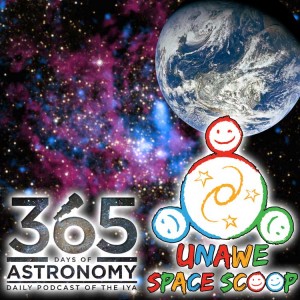Podcaster: Pamela Quevillon
Title: Beyond the Horizon
Organization: Speak Easy Narration
Link : http://speakeasynarration.com ; http://www.unawe.org/kids/unawe1366/
Description: Space scoop, news for children. Today’s we bring you Sun-like stars puff away their outer layers of gas at the end of their lives. Planetary Nebula
Bio: Pamela Quevillon is a voice actress who most often lends her voice to science and science fiction content. You can find her work on the “Escape Pod” and “365 Days of Astronomy”, as well as on her site
Today’s sponsor: This episode of “365 Days of Astronomy” is sponsored by — no one. We still need sponsors for many days in 2013, so please consider sponsoring a day or two. Just click on the “Donate” button on the lower left side of this webpage, or contact us at signup@365daysofastronomy.org.
Transcript:
 For a long time people believed that the Earth was flat and that if you sailed too far you’d fall over the edge! It seems funny they could have thought that, because now we’re lucky enough to have pictures of our entire planet and we can see its shape (take a look at image 2). But it took some pretty impressive technology to get these pictures, which wasn’t available to our ancient ancestors. Did you know you have to travel about 20,000 kilometres from Earth to be able to see the entire planet?
For a long time people believed that the Earth was flat and that if you sailed too far you’d fall over the edge! It seems funny they could have thought that, because now we’re lucky enough to have pictures of our entire planet and we can see its shape (take a look at image 2). But it took some pretty impressive technology to get these pictures, which wasn’t available to our ancient ancestors. Did you know you have to travel about 20,000 kilometres from Earth to be able to see the entire planet?
Now imagine how far into space you’d have to travel to fit all the 300 billion stars of the Milky Way (our Galaxy) into one shot! This is way beyond our abilities at the moment, but we can photograph small sections of the Galaxy. This picture from the Chandra X-ray Observatory shows the very centre of the Milky Way. This is the most chaotic and dangerous part of the Galaxy, and home to a supermassive black hole.
Anything that gets too close to a black hole is pulled into it with such a strong force that it has no chance of escape. The boundary that marks the point of no return is called the event horizon. Past this not even light will return: this monster will pull it in forever. The blue haze in this picture includes piping-hot gas floating perilously close to the event horizon of our Galaxy’s supermassive black hole. But astronomers have found that just a tiny amount of this gas will be gobbled up by the black hole, and the rest will be “spat out” before it gets too close.
Cool Fact
Image 2 shows a picture of the Earth as a whole planet from space. It was taken by astronauts during the Apollo 8 mission in 1968. This was the first manned spacecraft to reach the Moon, which they orbited around before returning safely to Earth. The crew were the first people to ever see this view of Earth!
365 Days of Astronomy is a community podcast made possible thanks to the contributions of people like you. Please consider donating at 365DaysofAstronomy.org/Donate
End of podcast:
365 Days of Astronomy
=====================
The 365 Days of Astronomy Podcast is produced by the New Media Working Group of the International Year of Astronomy 2009. Audio post-production by Preston Gibson. Bandwidth donated by libsyn.com and wizzard media. Web design by Clockwork Active Media Systems. You may reproduce and distribute this audio for non-commercial purposes. Please consider supporting the podcast with a few dollars (or Euros!). Visit us on the web at 365DaysOfAstronomy.org or email us at info@365DaysOfAstronomy.org. In the new year the 365 Days of Astronomy project will be something different than before….Until then…goodbye.

